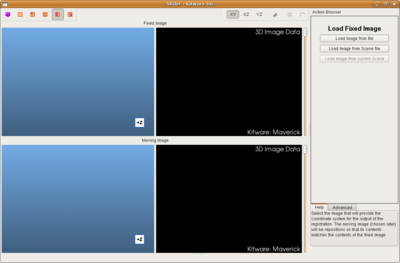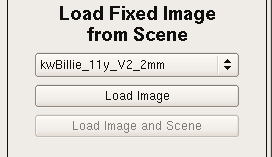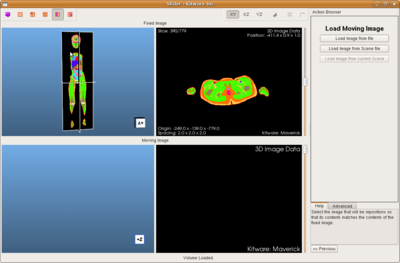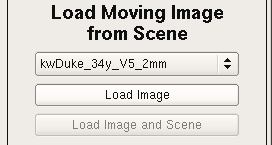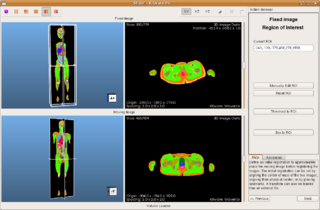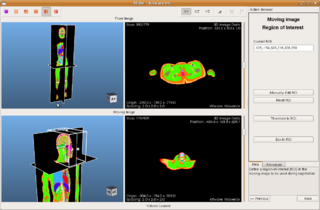Maverick/Slider
Slider
Slider is the Registration Application of Maverick. The application registers an image (moving) into an other image (fixed). Below is a short tutorial to use Slider.
Before starting
Slider can import images ( *.mha *.mhd *.gipl *.jpg *.bmp *.nrrd ) and scenes (*.mrml). By loading a scene in Slider, you can extract any image from the scene. Importing a scene can be useful if you want to import a LabelMap. Loading a LabelMap directly (*.mha) will not contain any label description, this is why you should load the LabelMap through a scene. You can use Maverick/Merlin to create MRML scenes ( e.g. use the Resample module to lower the resolution of your images ).
In this tutorial, we register two bodies from the Virtual Family. Duke(moving image) is registered with Billie(fixed image). A result image is saved with the head of Duke and the body of Billie. Billie and Duke are stored in separate mrml scene files. We previously made sure that they shared the same tissue file.
Here is the list of the files used for this tutorial:
- Duke.mrml
- kwDuke_34y_V5_2mm.mha
- VirtualTissue.csv
- Billie.mrml
- kwBillie_11y_V2_2mm.mha
- VirtualTissue.csv
Loading a Fixed Image
The first screen invites you to select a fixed image. An image can be directly from a file or from a scene file. Loading a scene leads to another screen menu that lists all the volumes contained by the scene file. A volume must be selected from the list before clicking on Load Image. If the fixed and moving images are both contained by the loaded scene, Load Image and Scene loads the fixed image and cache the other volumes contained by the scene so they can be later used in the Load Moving Image menu.
In our example, we first click on Load Image from Scene File, in the new menu we choose kwBillie_11y_V2_2mm in the volume list to finally click Load Image.
The fixed image (the labelmap of Billie) is loaded in the top 3D and 2D views.
Loading a Moving Image
The second screen Load Moving Image invites you to select a moving image. This is the image to be registered with the already loaded fixed image. The process is the same than for the fixed image loading menu. If a scene has been previously loaded using Load Image and Scene, a third choice Load Image from Current Scene is available and allow the user to select a volume from the cache.
In our example, we click on Load Image from Scene File, in the next menu we choose kwDuke_34y_V5_2mm.mha in the volume list to finally click Load Image.
The moving image (the labelmap of Duke) is loaded in the bottom 3D and 2D views.
Defining a Region of Interest for the Fixed Image
The fixed and moving images loaded, you can now define a region of interest for the fixed image. ROIs are used to limit the need of memory in the next steps. This is particularly useful when the images sizes and resolutions are different; the result image can get very big ( low-def heaf registered with a high-def eye, the result high-def head may use > 6GB of RAM ). By moving the anchor points of the 3D box widget in the 3D view, the final ROI of the fixed image is set. Click on Next> to apply your changes.
In our example we want to keep the whole volume of Billie, this is why set the size of the ROI to be the same than the volume ( default ).
Defining a Region of Interest for the Moving Image
Modify the moving image region of interest and click Next to apply.
In our example, we shrink the ROI to the size of the head only as we want only the head of Duke in the final image.
